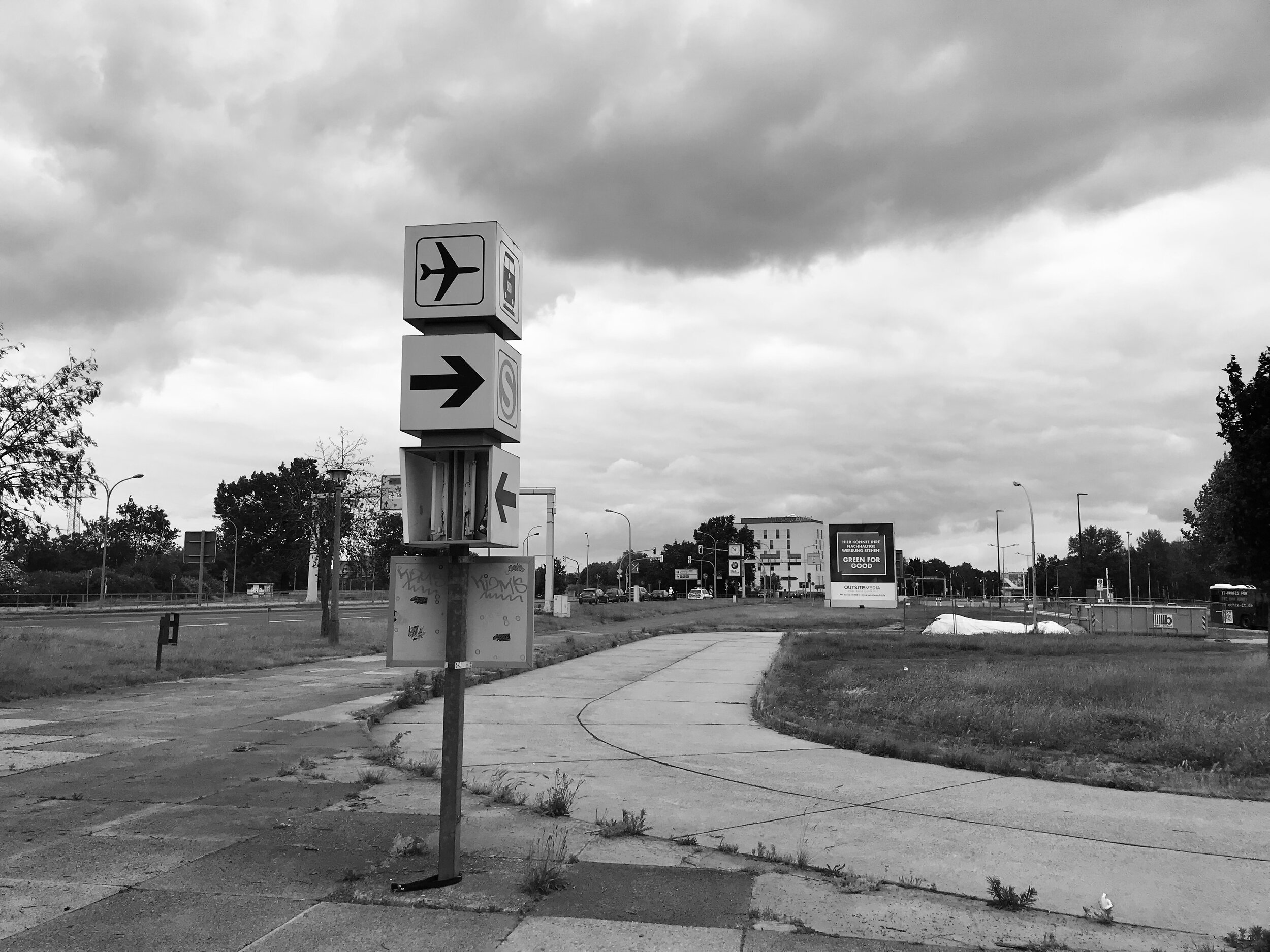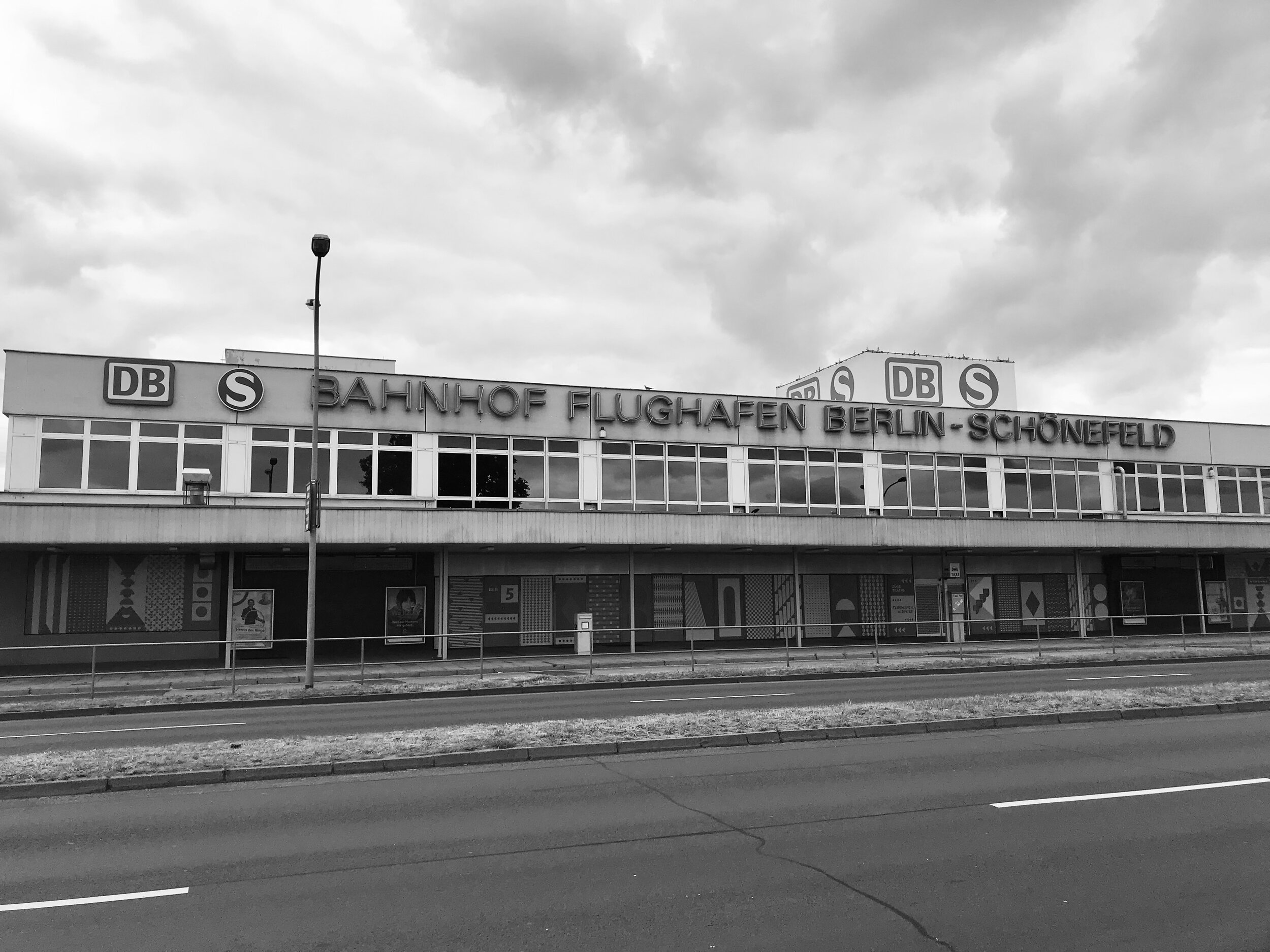Arrival/Departure by Paul Scraton
Arrival / Departure is a combination of an audio essay with field recordings about the station of what was once Berlin Schönefeld Airport and what is now known as Terminal 5 of the newly opened Berlin-Brandenburg International. When I first arrived in Berlin in October 2001, I landed on an Easyjet flight from London Stansted at Schönefeld and it was the start of a three-month journey through Europe that would begin with a week in Berlin. I couldn’t have imagined, when waiting for the train at the airport station on that sunny autumn day, that I would still be in this city almost 20 years later.
For Place 2021 I chose the station of what I still called Schönefeld Airport because of what it represents in both my own story in this city but also of our particular moment in time. As you will hear in the essay (or read below), SXF was, by the time I came to Germany, predominantly the domain of the budget airlines, while the flag carriers and long-haul routes were mainly served by Tegel, closer to the city centre. So although there was the odd flight in and out of Tegel, Schönefeld was my connection to ‘back home’, to the Lancashire of my childhood and my friends and family in Yorkshire and Ireland, to book readings and festivals in London, and to holidays in Wales and Scotland. For me, Schönefeld always symbolised arrival and departure, the link to the two places that make up my identity (and now the two passports in my drawer), and I write and record this at a time when the link between those two places has been broken, starting with the Brexit Referendum of 2016 and more practically, with the implications of the pandemic.
– Paul Scraton, Berlin, June 2021
Arrival / Departure
The first time you came here, almost twenty years ago, the station looked to have already begun its long process of gradual abandonment. The main building was an echoing hall, its retail units empty. No flags flew from the rusting poles outside. Most of the platforms were not in use, with grass and dandelions growing through cracks in the concrete.
If there was life it was down in the tunnel, a damp space where a number of kiosks plied their trade for the passengers coming to and from the airport. They sold beer and little bottles of schnapps, cigarettes and bockwurst. They also had a group of regulars, who stood at high tables or sat on plastic chairs advertising soft drinks. Those who flew in and out from Schönefeld a lot in those days would have come to recognise the faces of the regulars, the permanent residents of the tunnel.
On that first day, the day of arrival, the sun was shining. You stood at a ticket machine outside the terminal building, unsure of what buttons to press. A woman from the British Embassy helped. She knew the routine. The back and forth. She might have recognised the faces down in the tunnel. You remember she carried a canvas shoulder bag and a copy of the Guardian. Details. She asked where you wanted to go, and she was asking where you would be staying, because she could tell you were already lost.
Rosa-Luxemburg-Platz. Back home, you ate your breakfast each morning with Rosa, a postcard pinned to the kitchen wall in Lancashire. On the plane you had looked at a city map, and all the place names of the city that resonated with memories. These were not memories of Berlin itself, not yet. But of things seen and things read. Rosa-Luxemburg-Platz and Karl-Marx-Allee. Zoologischer Garten and Wir Kinder vom Bahnhof Zoo.Tiergarten and Potsdamer Platz. Kreuzberg and Prenzlauer Berg. Alexanderplatz and Ostbahnhof. Wannsee.
You followed her onto a shuttle bus to the station, one that would eventually be replaced with a covered walkway, because that was all the passengers of the budget airlines deserved. On the platform she opened her newspaper and began to read. She read all the way into the city, until the moment the train approached Alexanderplatz, when she dropped the paper slightly and looked up to catch your eye. This was where you had to get off.
Over the next twenty years you would pass through the station many times, hurrying down to the tunnel to catch a plane, waiting for the train to take you closer to what was increasingly becoming home. It is a period of time that was unfathomable then and feels improbable now. One week became two decades. And over time, the station collected memories.
It always did, and not all of the memories are yours. The past grows out of the cracks in the platform with those blades of grass and dandelions, symbols of time and abandonment, of loss. The yellow flower, growing by the door of a long disused waiting room, tells the story of every footstep that hasn’t trodden it down. Of the trains that used to call here and no longer do.
They built airplanes here during the war, and then it became an airfield for an occupation sector, eventually an airport for a nation. In 1962, not long after the Berlin Wall was built, Berlin’s Schönefeld Airport opened just beyond the city limits and inside the terminal building today you can see its era of origin in the polished floors and, up the stairs, the curtain windows and its mezzanine floor.
But the station already existed before, anticipating both the airport and the closing of the borders that would turn West Berlin into an island. It was part of the Outer Ring, a railway that allowed goods and eventually passengers to bypass the territory that belonged to the other side. These trains became known as Sputniks, orbiting the West on a journey from Berlin-Karlshorst via Schönefeld to Potsdam on the southern loop. On the maps, West Berlin was just a white blank space.
To arrive in Schönefeld during those years of division was an experience often recounted by those who were not used to it. Peter Schneider tells the tale in the opening pages of his short novel The Wall Jumper, beginning with the descent across what he calls the Siamese city. It is winter when he arrives, and the travellers catch the bus from the bottom of the plane’s steps to the terminal building, a mix of clothing styles and accents that offer clues only to be confirmed when they divide at the end of the short journey across the airfield. Some will go left, for the GDR. Others will go right, with Schneider himself, for the FRG.
West Berliners could use the airport via a shuttle bus that connected them with their half of the city and their own dedicated terminal. According to their passports, they never entered the GDR and they never made it to the station, where the Sputniks stopped as well as the S-Bahn, regional trains and Intercitys. When the Wall came down, Schönefeld was demoted. No longer the main entry point to a nation, it became Berlin’s third airport and domain of the budget airlines. That’s why it was your point of arrival in this city. An orange plane and a two-figure ticket. Would the future have been different if you’d landed at Tegel or Tempelhof?
For the airport and the station, the death sentence appeared to come with the announcement of a brand new airport. As opening day approached, the station building was closed completely, with metal grids over the walkway that linked it with the tunnel beneath the platforms. The kiosks in the tunnel were removed. Schönefeld no more. Only, the new airport wasn’t ready, and it wouldn’t be for years. So Schönefeld stumbled on, as did its station.
The kiosks never returned. All that remained was the discoloured outlines on the floor where they had once stood, the long hall of the tunnel echoing with the voices of the regulars, who’d found new places to spend their days. The tunnel became a place purely of movement. Of transit. There were no permanent residents any more.
Outside the station, on the now-abandoned building, one by one the letters on the neon sign failed. At night...
BAHNHOF FLUGHAFEN BERLIN-SCHÖNEFELD
Became a jumble of letters.
BAH OF FLUG AF BERL -SC ÖN LD
They could not be fixed. It was impossible, in the second decade of the 21st century, to find the spare parts. They were back in the GDR. Repairs required an exercise in time travel.
The new airport has finally opened, but after years of delay, it was no longer big enough. Schönefeld, now renamed Terminal 5, stumbles on with a new name, as does its station. The Sputniks are long gone. As are the Intercitys, the regional trains and the airport expresses. Only the S-Bahn still calls, and will continue to do so, as long as there are still passengers who need to catch the train. Somehow the airport and its station survives. But is this extra time, or the afterlife?
It is eighteen months since you were last here on a journey. A flight to Dublin and a bus north, to those friendly, water-stained streets of Dundalk. Before that it was Liverpool and a familiar room just a short walk from the banks of the river. London and its bookshops. Manchester and the train across the Pennines to Leeds. Most of these flights were to take you to places you know, places that were all a kind of homecoming of sorts, even though the journey always began at home.
All of them to places that, for now at least, you still cannot reach.
How many homes can we have? Across the years that make up a life or all at once? There are people that say you cannot have two passports. Not really. That you cannot belong to two different places. But maybe it is the other way round. The places belong to you, and the platforms and the stations and the airports are what helps you link them. The places belong to you. And you get to choose.
Eighteen months and twenty years. So many arrivals and departures. For the first time, this is neither an arrival or a departure. Or perhaps it is both. For the first time, it is a destination of its own. It is nice to be on the platform again, travelling through its memories, waiting for a train.



